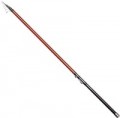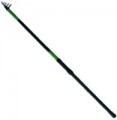Max. casting
The maximum weight of the entire rig (including bait, weights, hooks, etc.) that the rod can handle. This parameter is not recommended to be exceeded: the structure will be subjected to off-design loads and wear out a lot, to the point that the rod can simply break during a normal cast. In addition, the off-design weight of the casting significantly reduces the range and accuracy of the cast, which is critical, in particular, in spinning and match fishing (see "Rod type").
Min. casting
The minimum weight of equipment (lures, sinkers, hooks, floats, etc.) with which the rod will work effectively. Compliance with this parameter is important, first of all, for types of fishing that require high accuracy, for example, match or spinning (for more details, see "Rod Type") — a rig that is too light will not allow you to cast the rod far enough and accurately.
Sections
The number of sections provided in the design of the folding rod (see "Design"). Of two rods of the same length, a model with more sections will have a smaller length of each individual section and, accordingly, will be more compact and easier to transport. On the other hand, numerous sections adversely affects the overall strength of the structure. Therefore, when choosing, it is desirable to decide what is more important for you — ease of transportation or high strength.
Working length
The length of the rod in the unfolded (working) position. For different types of fishing, different lengths are considered optimal; see "Rod Type" for more on this. If the type of rod you need has numerous length variations, when choosing, you should take into account the conditions in which you have to fish. On the one hand, longer models usually have a greater casting distance (this is especially true for float fishing); on the other hand, for limited conditions (for example, with dense vegetation on the shore or when fishing from a boat), it may make sense to take a shorter rod.
Folded length
The length of the rod when folded. This parameter primarily affects the convenience of transportation: the shorter the folded rod, the easier it is to carry / transport.
Rod material
—
Fiberglass. One of the earliest synthetic materials used in modern rods appeared in the middle of the 20th century. It is a substance consisting of thin elongated filaments of ordinary glass. However, unlike the usual form of glass (for example, window glass), fiberglass is a soft and fairly shock-resistant material — for example, rods made of it are much more unpretentious than
graphite and carbon fiber (see below), less sensitive to bumps and falls, and are significantly cheaper. The main disadvantage is the significant weight, which creates inconvenience if you need to often cast the bait (for example, when fishing with a lure from the shore). In addition, fiberglass is less resilient and less resistant to bending than the mentioned "carbon" materials.
—
Composite. Most often, composite rods are made from a mixture of carbon fiber and fiberglass. The first material has good rigidity and bending resistance, but is rather brittle; the second is not so hard, but at the same time less sensitive to bumps, falls, etc. The combined design allows you to combine the advantages of both materials and compensate for the disadvantages. Note that the proportions of this mixture are different, and therefore composite rods can differ greatly from each other in terms of characteristics; it is desirable to clarify this point separately before purchasing.
—
Carbon (graphite). A type of carbon fiber is a synthetic material made up of thin strands of carbon. The main advantage of carbon is its high resistance to bending, which is very important when pulling large prey. In addition, this material is quite light and resistant to bad weather, temperature changes, etc. On the other hand, such rods do not tolerate shocks, falls on a hard surface, etc. and require careful handling — in particular, it is highly desirable to use covers during transportation. However, the advantages of carbon far outweigh its disadvantages, and therefore it is one of the most common materials for modern rods of various types.
This item also includes graphite rods. This is one of the varieties of carbon fiber, somewhat simplified compared to carbon fiber and, accordingly, less expensive. Graphite tolerates heavy bending loads worse, and therefore is used mainly in Bologna and float rods. In addition, due to its plasticity and "biting", this material is also suitable for match models.

